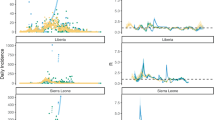Abstract
Surveillance of influenza epidemics is a priority for risk assessment and pandemic preparedness, yet representation of their spatiotemporal intensity remains limited. Using the epidemic of influenza type A in 2016 in Australia, we demonstrated a simple but statistically sound adaptive method of mapping epidemic evolution over space and time. Weekly counts of persons with laboratory confirmed influenza type A infections in Australia in 2016 were analysed by official national statistical region. Weekly standardised epidemic intensity was represented by a standard score (z-score) calculated using the standard deviation of below-median counts in the previous 52 weeks. A geographic information system (GIS) was used to present the epidemic progression. There were 79,628 notifications of influenza A infections included. Of these, 79,218 (99.5%) were allocated to a geographical area. The GIS maps indicated areas of elevated epidemic intensity across Australia by week and area that were consistent with the observed start, peak and decline of the epidemic when compared with counts aggregated at the state and territory level. This simple, adaptable approach could improve local level epidemic intelligence in a variety of settings and for other diseases. It may also facilitate increased understanding of geographic epidemic dynamics.


Similar content being viewed by others
References
World Health Organization (2013) Global epidemiological surveillance standards for influenza. World Health Organization, Geneva http://www.who.int/influenza/resources/documents/influenza_surveillance_manual/en/. Cited 24 Jan 2018
Muscatello DJ, Chughtai AA, Heywood A, Gardner LM, Heslop DJ, MacIntyre CR (2017) Translation of real-time infectious disease modeling into routine public health practice. Emerg Infect Dis 23(5):e161720
CDC (2018) Fluview. United States Centers for Disease Control and Prevention, Atlanta, https://www.cdc.gov/flu/weekly/index.htm. Cited 2 Feb 2018
Australian Department of Health (2017) Australian Influenza Surveillance Report and Activity Updates. Australian Government Department of Health, Canberra, http://www.health.gov.au/flureport. Cited 15 Feb 2017
Vega T, Lozano JE, Meerhoff T, Snacken R, Beauté J, Jorgensen P, Ortiz de Lejarazu R, Domegan L, Mossong J, Nielsen J, Born R, Larrauri A, Brown C (2015) Influenza surveillance in Europe: comparing intensity levels calculated using the moving epidemic method. Influenza Other Respir Viruses 9(5):234–246
Bangert M, Gil H, Oliva J, Delgado C, Vega T, De Mateo S, Larrauri A (2016) Pilot study to harmonize the reported influenza intensity levels within the Spanish influenza sentinel surveillance system (SISSS) using the moving epidemic method (MEM). Epidemiol Infect 145(4):715–722
Pelat C, Bonmarin I, Ruello M, Fouillet A, Caserio-Schönemann C, Levy-Bruhl D, Le Strat Y, Regional Influenza study group (2017) Improving regional influenza surveillance through a combination of automated outbreak detection methods: the 2015/16 season in France. Euro Surveill 22 (32):pii=30593
Communicable Diseases Network of Australia (2015) Introduction to the National Notifiable Diseases Surveillance System http://www.health.gov.au/internet/main/publishing.nsf/Content/cda-surveil-nndss-nndssintro.htm. Cited 10 Apr 2019
Muscatello DJ, Amin J, MacIntyre CR, Newall AT, Rawlinson WD, Sintchenko V, Gilmour R, Thackway S (2014) Inaccurate ascertainment of morbidity and mortality due to influenza in administrative databases: a population-based record linkage study. PLoS One 9(5):e98446
Kelly HA, Grant KA, Tay EL, Franklin L, Hurt AC (2013) The significance of increased influenza notifications during spring and summer of 2010–11 in Australia. Influenza Other Respir Viruses 7(6):1136–1141
Sonesson C, Bock D (2003) A review and discussion of prospective statistical surveillance in public health. J R Stat Soc Ser A (Statistics in Society) 166(1):5–21
Oakland JS (1996) Statistical process control. Butterworth-Heinemann, Oxford, pp 181–189
Woodall WH (2006) The use of control charts in health-care and public-health surveillance. J Qual Technol 38(2):89–104
Australian Bureau of Statistics (2017) Australian statistical geography standard (ASGS). Australian Bureau of Statistics, Canberra, http://www.abs.gov.au/websitedbs/D3310114.nsf/home/Australian+Statistical+Geography+Standard+(ASGS) . Cited 29 Jan 2018
National Center for Immunization and Respiratory Diseases (2017) Overview of influenza surveillance in the United States. Centers for Disease Control and Prevention, Atlanta, https://www.cdc.gov/flu/weekly/overview.htm. Cited 27 Jan 2018
Acknowledgments
National Notifiable Diseases Surveillance System data on influenza were provided by the Office of Health Protection, Department of Health, on behalf of the Communicable Diseases Network Australia.
Funding
This research was supported by the 2017 Small Scale Research Support Scheme of the School of Public Health and Community Medicine, University of New South Wales.
Author information
Authors and Affiliations
Corresponding author
Additional information
Publisher’s note
Springer Nature remains neutral with regard to jurisdictional claims in published maps and institutional affiliations.
Rights and permissions
About this article
Cite this article
Muscatello, D.J., Leong, R.N.F., Turner, R.M. et al. Rapid mapping of the spatial and temporal intensity of influenza. Eur J Clin Microbiol Infect Dis 38, 1307–1312 (2019). https://doi.org/10.1007/s10096-019-03554-7
Received:
Accepted:
Published:
Issue Date:
DOI: https://doi.org/10.1007/s10096-019-03554-7




